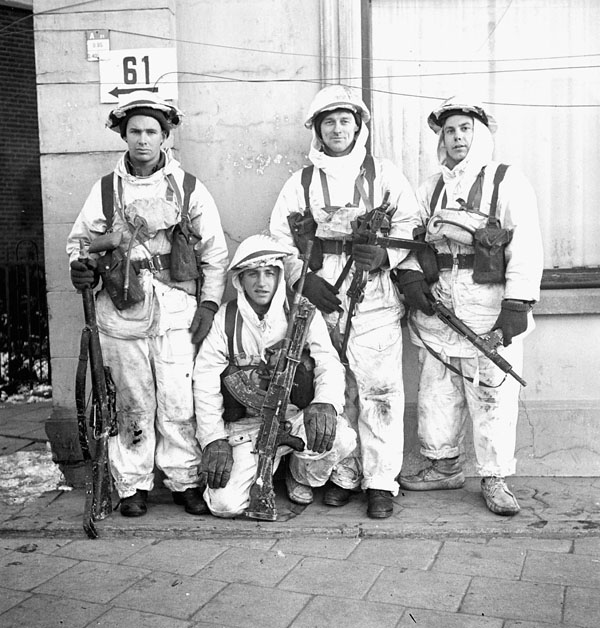The Battle of Kapelsche Veer
Operation ELEPHANT was an attack by the First Canadian Army to clear a small island north of the Maas River in the Netherlands, known as Kapelsche Veer. This is where German Paratroopers had set up a strong defensive position. The Canadian regiments dealt with difficult conditions and suffered high casualities, but on the morning of 31 January 1945, the German paratroopers evacuated the island.
After failed Polish and British attacks, First Canadian Army received the order to clear a small island north of the Maas River in the Netherlands where the 10th and 17th German Paratroop Regiment had established a small bridgehead.
Although the bridgehead posed no immediate threat, General John Crocker, Commander, 1st British Corps, was fearful that a major enemy assault across the Maas could still be attempted and wanted the German position eliminated.
Known as Kapelsche Veer, the flat low-lying island offered no cover aside from deep dykes and was notoriously cold, windy and water-logged in the winter. Roughly 150 German paratroopers held a strong defensive position between two brick houses, codenamed “Grapes” and “Raspberry.”
As part of Operation ELEPHANT, The Lincoln and Welland Regiment with the support of The Argyll and Sutherland Highlanders of Canadaand the South Alberta Regiment, were to clear the island by 31 January 1945. The plan called for the attack to commence at 7:30 AM on 26 January, “A” and “C” Companies of the Lincoln and Wellands attacking the eastern end of the island, with “B” Company crossing onto the centre of the island, and “D” Company being kept in reserve to be sent in as reinforcements where needed—the goal being a pincer movement on the enemy’s position.
Meanwhile, 60 volunteers were to set out in four-man canoes at the island’s eastern tip and paddle westward towards the harbour, ultimately digging in where they could prevent German reinforcements from crossing over by ferry onto the island. Because the canoe “commando” would come into range of German troops on both banks of the river and the three rifle companies would be exposed on top of the dykes, a thick smoke screen was to be used to help provide cover.
Unfortunately, nothing went as planned. “C” company’s Wasps (tracked flamethrowers) were unable to climb up the sides of the dykes and got stuck in the mud. Meanwhile, “A” Company managed to push forward along the dyke line and got close to its objective, but the combination of the smoke screen and enemy fire forced it to pull back. Soldiers in the canoes were hindered by thick ice covering the river and many had to wade into the fast moving water in order to untangle their boats causing their snow suits to become sodden and heavy.
As “A” Company waited for “C” company to arrive, the Germans started counterattacking and heavy mortar and machine gun fire caused casualties to mount alarmingly as the men desperately tried to dig into the frozen ground for cover. Over on the western side of the island, “B” Company moved northward towards its objective without incident until the smoke screen dissipated and the enemy, now only 50 yards away to the east, opened fire.
The canoes came under intense fire as they moved forward, soon forcing the soldiers—their rifles frozen and useless—to land on the bank near “A” Company. After intense fighting and severe casualties, “A” and “C” Companies were forced back and “B” Company held on, awaiting reinforcements from “D” Company. Attempts to provide armoured support to the west also suffered from difficulties in ferrying the South Alberta Regiment’s tanks across the river.
Over the next five days the Argylls, with the support of the South Albertas and what was left of the Lincoln and Wellands continued to hold their position on the island. Although they tried to advance closer towards the two houses, an extensive series of enemy underground tunnels and a seemingly endless supply of ammunition made gaining any ground difficult and costly.
The enemy’s counter attacks were fierce but they were also suffering from high casualties and frostbite. Every man on the island was busy digging in to stay warm but stress and exhaustion took their toll. Multiple attempts were made by the Canadians to attack the harbour, with the support of a few tanks ferried across the river.
Poor weather conditions like rain, sleet and snow as well as the shelling made the ground turn to mud, leaving a lot of tanks bogged down and useless. By the night of the 29/30 January, sheer exhaustion was making it difficult for the Canadians to hold their ground, but a few final attacks on the objectives were made.
On 30 January, the Germans tried twice more to bring reinforcements onto the island but their ferries were sunk in the river. On the morning of 31 January a massive German artillery barrage covered the evacuation of the remaining German paratroopers from the island.
Operation ELEPHANT had a staggering effect on the Lincoln and Welland Regiment which suffered more than 183 casualties (including 50 dead) in only six days of fighting. Using a combination of historical research and forensic anthropological analysis, the Directorate of History and Heritage of the Department of National Defence has identified the following soldier whose remains were recovered due to modern human activity.
- Laubenstein, Albert, Lincoln and Welland Regiment
More on casualty identification
Page details
- Date modified:


